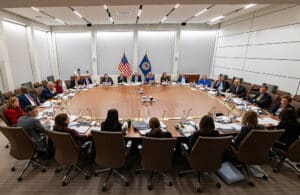
Federal Open Market Committee participants sit around a conference table at the William McChesney Martin Jr. Building in Washington, D.C., during their two-day, interest rate-setting meeting March 15-16, 2022. Federal Reserve photo
Bill Nelson has experienced the workings of the Federal Reserve from both sides of the street.
Nelson is the chief economist of the Bank Policy Institute, a trade group for U.S. banks. Earlier in his career, he served as an economist at the Federal Reserve and rose to become deputy director of the Division of Monetary Affairs, which provides guidance for the Fed’s interest rate decisions.
Like many economists, Nelson says the Fed took too long this year to start raising rates. He favors a more forward-looking strategy from the Fed, which has recently made several sharp policy shifts in response to the latest economic data. The Associated Press spoke recently with Nelson.
Q: Fed officials, including Chair Jerome Powell, have acknowledged that with hindsight, they could have started raising rates earlier than they did. What do you think of their policy now?
A: They’re on the right track. Not 100 percent sure they’re following the right strategy, but I think the path they are on is a good one.
Q: Where do you disagree?
A: Part of the problem that left them where they are was initially a desire to focus on realized inflation rather than the outlook for inflation. It’s understandable, given that the outlook was very difficult to predict. But monetary policy needs to be a forward-looking exercise, based on forecasts. It can’t be based on looking out the window. Even though they have now adjusted to a rapid pace of tightening, they still seem to be responding to what they’re seeing outside the window rather than looking ahead.
You could make a mistake – in either direction – by looking at current inflation. Inflation could remain high even though spending is weakening. And in light of that, you don’t want to keep raising rates if you’re already slowing growth. But on the other hand, there’s going to be a reduction in inflation that occurs simply because the transitory components are passing through. And you wouldn’t want to respond to that, either, by stopping rate hikes.
Q: Is the Fed fully focused on raising rates, or might they pull back soon, out of fear of rising unemployment and recession?
A: Sometimes, the dual mandate can give conflicting directions in terms of what the Fed needs to do: The need to have inflation be roughly 2 percent and the unemployment rate near full employment. But this isn’t one of those times. The labor market is very tight, and inflation is very high. They need to position monetary policy so that it’s very restrictive in terms of economic growth. They don’t want to cause an unnecessarily deep recession. What they’re shooting for is a position of sufficient restraint to slow the economy to bring inflation back down.
But I am confident that when there are more signs of slowing growth and signs of inflation falling, they will be weighing both of those together.






